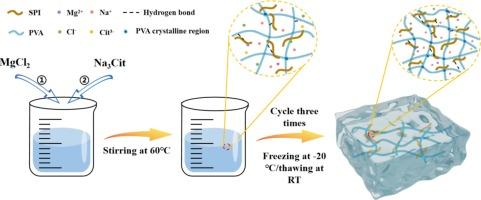One-pot preparation of strong, tough, frost-resistant and recyclable organohydrogels via Hofmeister effect and its application for electronic devices
IF 5.8
2区 化学
Q1 POLYMER SCIENCE
引用次数: 0
Abstract
Conductive hydrogels have shown a great potential in the field of flexible electronics. However, it is difficult to combine high strength and high toughness in conductive hydrogels prepared by conventional methods, which limits their applications in various fields. In this work, we pioneered a facile and cost-effective strategy to prepare soy protein isolate/poly(vinyl alcohol) (SPI/PVA) conductive hydrogels with high strength, toughness, low-temperature resistance, and recyclability by introducing all the salts into the prescuor solution directly. To solve the problem of unable to directly introducing high concentration Na3Cit into the soy protein isolate/PVA solution, MgCl2 was used to alleviate the strong salting-out effect of Na3Cit. Thus the stable SPI/PVA/EG/MgCl2/Na3Cit complex solution was obtained and the SPI/PVA/EG/MgCl2/Na3Cit (SPEMS) organohydrogel was prepared by the freezing/thawing process. The optimum tensile strength of the SPEMS organohydrogel was 1.1±0.07 MPa, and the elongation at break was 701.3±23.67 %, respectively. Meanwhile, the ionic conductivity of the organohydrogel was as high as 1.7±0.01 S/m. Finally, the EG/H2O binary solvent system endowed the organohydrogel with excellent low-temperature resistance (freezing point of −19.4 °C). The strain sensors assembled with SPEMS organohydrogels were characterized by high sensitivity (GF = 3.2, strain range from 20 %–500 %) and long-term stability. The flexible all-solid-state supercapacitor assembled with SPEMS organohydrogel as the electrolyte and activated carbon as the electrodes has a high area specific capacitance (113.76 mF/cm2) and good cycling stability (capacitance retention of 81.62 % after 1,000 charging and discharging cycles) at room temperature.

通过霍夫迈斯特效应一锅制备强韧、抗冻和可回收的有机水凝胶及其在电子设备中的应用
导电水凝胶在柔性电子领域显示出巨大的潜力。然而,传统方法制备的导电水凝胶很难兼具高强度和高韧性,这限制了其在各个领域的应用。在这项工作中,我们开创了一种简便、经济高效的策略,通过将所有盐类直接引入预处理溶液,制备出具有高强度、高韧性、耐低温和可回收性的大豆分离蛋白/聚乙烯醇(SPI/PVA)导电水凝胶。为了解决无法直接将高浓度 Na3Cit 引入大豆分离蛋白/PVA 溶液的问题,使用 MgCl2 来缓解 Na3Cit 的强脱盐效应。这样就得到了稳定的 SPI/PVA/EG/MgCl2/Na3Cit 复合物溶液,并通过冷冻/解冻工艺制备出了 SPI/PVA/EG/MgCl2/Na3Cit (SPEMS)有机水凝胶。SPEMS有机水凝胶的最佳拉伸强度为1.1±0.07 MPa,断裂伸长率为701.3±23.67 %。同时,有机水凝胶的离子导电率高达 1.7±0.01 S/m。最后,EG/H2O 二元溶剂体系赋予了有机水凝胶优异的耐低温性能(冰点为 -19.4°C)。用 SPEMS 有机水凝胶组装的应变传感器具有高灵敏度(GF = 3.2,应变范围为 20 %-500 %)和长期稳定性的特点。以 SPEMS 有机水凝胶为电解质、活性炭为电极组装的柔性全固态超级电容器在室温下具有较高的面积比电容(113.76 mF/cm2)和良好的循环稳定性(1000 次充放电循环后电容保持率为 81.62%)。
本文章由计算机程序翻译,如有差异,请以英文原文为准。
求助全文
约1分钟内获得全文
求助全文
来源期刊

European Polymer Journal
化学-高分子科学
CiteScore
9.90
自引率
10.00%
发文量
691
审稿时长
23 days
期刊介绍:
European Polymer Journal is dedicated to publishing work on fundamental and applied polymer chemistry and macromolecular materials. The journal covers all aspects of polymer synthesis, including polymerization mechanisms and chemical functional transformations, with a focus on novel polymers and the relationships between molecular structure and polymer properties. In addition, we welcome submissions on bio-based or renewable polymers, stimuli-responsive systems and polymer bio-hybrids. European Polymer Journal also publishes research on the biomedical application of polymers, including drug delivery and regenerative medicine. The main scope is covered but not limited to the following core research areas:
Polymer synthesis and functionalization
• Novel synthetic routes for polymerization, functional modification, controlled/living polymerization and precision polymers.
Stimuli-responsive polymers
• Including shape memory and self-healing polymers.
Supramolecular polymers and self-assembly
• Molecular recognition and higher order polymer structures.
Renewable and sustainable polymers
• Bio-based, biodegradable and anti-microbial polymers and polymeric bio-nanocomposites.
Polymers at interfaces and surfaces
• Chemistry and engineering of surfaces with biological relevance, including patterning, antifouling polymers and polymers for membrane applications.
Biomedical applications and nanomedicine
• Polymers for regenerative medicine, drug delivery molecular release and gene therapy
The scope of European Polymer Journal no longer includes Polymer Physics.
文献相关原料
公司名称
产品信息
阿拉丁
PVA
 求助内容:
求助内容: 应助结果提醒方式:
应助结果提醒方式:


